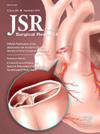番茄红素抑制小鼠模型术后腹部粘连的形成
IF 1.8
3区 医学
Q2 SURGERY
引用次数: 0
摘要
导言:预防术后腹腔粘连是腹部手术后外科医生最关心的问题之一。因此,确定减少术后腹腔粘连的有效干预措施至关重要:方法:将 50 只雄性 Bagg's albino/c 小鼠随机分为 5 组,除假组外,其余各组均接受术后粘连模型手术。假组和对照组灌胃生理盐水。在对照组的基础上,透明质酸钠组使用 1 mL 透明质酸钠(涂抹在造模部位并关闭腹腔)。另外两组分别灌胃不同剂量的番茄红素(10 μg/kg和20 μg/kg)。手术七天后,小鼠被处死,并使用奈尔评分系统评估粘附情况。随后,收获粘连组织,使用血红素和伊红染色法以及白细胞介素-6和转化生长因子-β1的酶联免疫吸附试验评估炎症情况。还检测了每只小鼠的氧化应激和胶原蛋白沉积情况。结果:20 μg/kg番茄红素处理组的奈氏评分和炎症评分较低,平均分均为1.75。此外,番茄红素 20 μg/kg 治疗组的转化生长因子-β1 和白细胞介素-6 水平也低于其他组。此外,与其他组相比,20 μg/kg 番茄红素可降低粘附组织中的活性氧和丙二醛水平。番茄红素处理后,粘附组织中的纤维厚度和α-平滑肌肌动蛋白表达明显减少。此外,20 μg/kg 番茄红素还能促进核因子红细胞 2 相关因子 2 和沉默信息调节因子 1 的表达。在体外研究中,番茄红素能保护间皮细胞免受 H2O2 诱导的氧化应激损伤:番茄红素可通过减少炎症和氧化应激减轻小鼠模型的腹腔粘连,其可能的机制可能是促进核因子红细胞 2 相关因子 2 和沉默信息调节因子 1 的表达。本文章由计算机程序翻译,如有差异,请以英文原文为准。
Lycopene Inhibits Postoperative Abdominal Adhesion Formation in a Mice Model
Introduction
The prevention of postoperative abdominal adhesions is one of the top concerns of surgeons after abdominal surgery. Therefore, identifying effective interventions to reduce postoperative abdominal adhesions are essential.
Methods
Fifty male Bagg’s albino/c mice were randomly divided into five groups, and all groups underwent postoperative adhesion model surgery, except for the sham group. The sham and control groups were gavaged with saline solution. Based on the control group, the sodium hyaluronate group was treated with 1 mL sodium hyaluronate (smeared on the modeling site and the abdominal cavity was closed). The other two groups were gavaged with different doses of lycopene (10 μg/kg and 20 μg/kg). Seven d after surgery, the mice were sacrificed and adhesion conditions were assessed using Nair's scoring system. Subsequently, adherent tissues were harvested and the inflammation was assessed by using haematoxylin and eosin staining and enzyme linked immunosorbent assay for interleukin-6 and transforming growth factor-β1. Oxidative stress and collagen deposition condition were also detected in each mouse. Furthermore, a lycopene-induced HMrSV5 cell model was used to explore the possible functional mechanisms.
Results
20 μg/kg of lycopene-treated group had a lower Nair's and inflammation score, both with an average score of 1.75. Also, the level of transforming growth factor -β1 and interleukin-6 in the 20 μg/kg of lycopene-treated group was lower than others. Furthermore, 20 μg/kg of lycopene had reduced the reactive oxygen species and malondialdehyde levels in adhesion tissues compared to other groups. Fiber thickness and α-smooth muscle actin expression in adherent tissues were significantly reduced after lycopene treatment. Besides, 20 μg/kg of lycopene treatment can promote the expression of nuclear factor erythroid 2-related factor 2 and silent information regulator 1. In in-vitro studies, lycopene protected mesothelial cells from H2O2 -induced oxidative stress injury.
Conclusions
Lycopene can attenuate abdominal adhesion in the mice model by reducing inflammation and oxidative stress, and the possible mechanism may rely on promoting the expression of nuclear factor erythroid 2-related factor 2 and silent information regulator 1.
求助全文
通过发布文献求助,成功后即可免费获取论文全文。
去求助
来源期刊
CiteScore
3.90
自引率
4.50%
发文量
627
审稿时长
138 days
期刊介绍:
The Journal of Surgical Research: Clinical and Laboratory Investigation publishes original articles concerned with clinical and laboratory investigations relevant to surgical practice and teaching. The journal emphasizes reports of clinical investigations or fundamental research bearing directly on surgical management that will be of general interest to a broad range of surgeons and surgical researchers. The articles presented need not have been the products of surgeons or of surgical laboratories.
The Journal of Surgical Research also features review articles and special articles relating to educational, research, or social issues of interest to the academic surgical community.

 求助内容:
求助内容: 应助结果提醒方式:
应助结果提醒方式:


